Sewer manholes: a review of species, their sizes and classification + what to look for when choosing
Modern sewer manholes are elements of engineering systems that provide protection for both underground networks and users. They are installed above drainage, rotary, collector, inspection and storage wells. Apply in arrangement of all types of underground communication facilities.
You will learn all about the types of hatches for arranging the sewage system and the rules for selecting them for their intended purpose from the article we have presented. We will talk about how to decide on a model depending on pedestrian and traffic loads. Based on our recommendations, you can easily find the best option.
The content of the article:
Hatch classification options
The main central and household communications for various purposes are underground. For regular inspection, maintenance of proper order and scheduled repairs, they require convenient and safe access. It is provided by special wells with an external hatch.
According to the purpose of the products
The primary classification of hatches is carried out according to the purpose and directly depends on the type of pipes or cables that need protection.
In total, four main groups appear here:
- water supply network;
- rainfall;
- telecommunication complex;
- sewer drains.
Hatches of the first group carefully cover individual fragments and nodes of the heating main and water supply system. The depth of the viewing wells is 1-2 meters.
In the last century, only cast-iron hatches were used to seal the outlet openings. Now they are successfully replaced by lightweight structures made of modern polymer compositions and progressive composites.
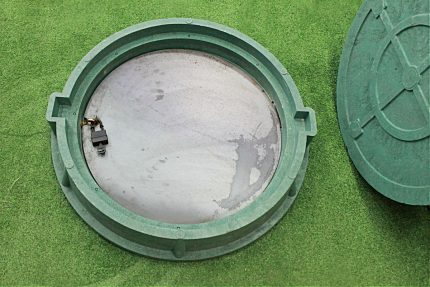
For rainfall, a hatch is necessary in order to protect networks from intrusion. Collector wells storm sewer sometimes it reaches 6 meters in depth. In the mine are metal reinforcing elements that pose a threat to humans or animals in the fall.
To reliably close the opening of a storm well, hatches with covers made of the same material as the main drainage line are used.
The telecommunication complex - electrics, telephony, broadband Internet - provides for the use of hatches to protect valuable equipment and to protect the system from unauthorized entry by third parties.
Typically, such networks are equipped with lightweight plastic hatchesequipped with an advanced and reliable lid locking mechanism. Sewer pits are equipped with hatches with a cover. For the most part, they are used in the private sector, where a central sewage system is not available.
The hatch prevents leakage of unpleasant odors from sewage accumulating in a single place. Provides access to the cesspool workers engaged in pumping out cesspools. In such a situation, it makes no sense to splurge on an expensive cast-iron component. The budget plastic sunroof will quite cope with the task.
There is another version of the model called the revision hatch. It provides access to the main work nodes water supply systems and drainage. It is mainly located inside sanitary-hygienic premises under a bathtub or in a wall sheathed with plastic siding or drywall.
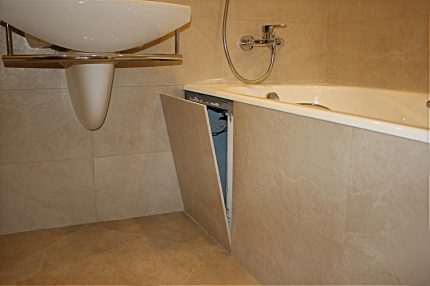
For more convenient recognition of the purpose of hatches, they are marked with an abbreviation in the form of letters.
Designations are decrypted very easily:
- AT - water module;
- G, PG - traditional / underground fire hydrant;
- TO - sewage production or household type;
- D - rainwater;
- HS - gas distribution network of local importance;
- GTS, MTS - urban telephone communication complex;
- MG - gas pipeline of the main type;
- T - phone;
- TS - heating system.
On some models of the hatch, the purpose is not reflected in letters, but in a characteristic pattern.
Varieties by size
Manufacturers offer round and square caps. Let's consider each of these groups in more detail.
View # 1 - round hatches
Round - a classic version of the protection of sewer wells from external penetration. They look neat and compact, fit comfortably into a mine and never fall inward, regardless of a possible reversal.
The operational load is distributed evenly over such a cover, and is not concentrated in separate areas.
With installation of round hatches over sewer well there are no problems, since the product can not only be brought to the installation site, but also rolled up. This is especially important when installation is not done by a team of workers, but by the owner of a personal site.

View # 2 - square and original shape
Square hatches are not so widespread. Their price exceeds the cost of round analogs, because more raw materials are spent on the creation.
Putting them alone is quite problematic, especially when it comes to super-heavy cast-iron models. Bringing such a product yourself to the installation site is almost impossible due to too much weight.
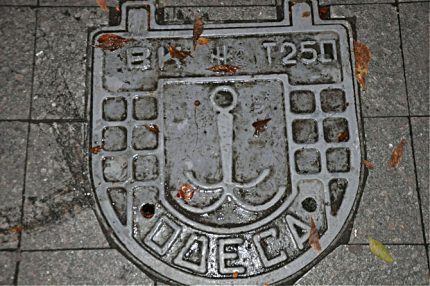
The main disadvantages of square hatches are their vulnerability to increased external pressure and the risk of failure inside the well during diagonal overturning. It is this moment that seriously reduces the popularity of products and makes them unsuitable for installation in areas of heavy traffic flow.
By weight and application areas
Household sewer hatches by weight are divided into heavy ("T" -type) and lungs ("L" -type) This factor determines the conditions and areas of their application. Models of type “T” are installed on motorways, highways, inner-city roads and carriageways of yards. Pig-iron products of this category weigh 90-100 kg, composite - up to 45 kg.
Polymer, rubber and plastic products are not represented here and are categorically not suitable for working under conditions of high mechanical load.
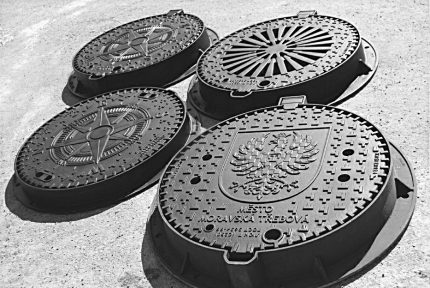
"L" -type of the product is suitable for installation on sidewalks, pedestrian walkways, in park areas and other places inaccessible to the movement of cars and trucks.
In cast iron complexes, the weight of the lid ranges from 55-90 kg. For polymer-composite parts - 45 kg, for polymer - from 12 to 15 kg.
Types of hatches by material
The following materials are suitable for the production of modern sewer manholes:
- high strength gray cast iron;
- plastic;
- polymer-sand mixture;
- composite composition;
- rubber;
- concrete / reinforced concrete.
Products in many ways differ significantly from each other and are intended for different purpose use. The manufacture and appointment of models is regulated by current SNiPs and GOSTs.
Features of cast iron hatches
For the manufacture of hatches, dense gray cast iron of the SCh20 class is used. This composition is an alloy of carbon, iron and graphite inclusions of different structures. It is characterized by good strength, is not afraid of mechanical damage, and easily tolerates intense global and local loads.
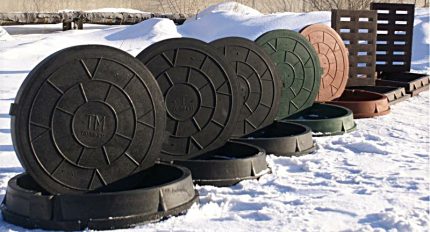
The cast iron hatch is characterized by high working and physical properties. During operation, it retains its original integrity, does not break and does not crack under the influence of an aggressive environment.
Among the most useful characteristics of heavy, solid models are the following items:
- service life from 30 to 100 years;
- maintaining the integrity of the structure and rigidity of the structure throughout the entire life cycle;
- neutrality to temperature changes, corrosive manifestations, humidity and other climatic factors;
- record resistance to loads and the ability to withstand weight from 25 to 40 tons;
- hinged locking mechanism that negates the possibility of the lid flying out during the movement of the transport stream along the highway;
- the presence of a rubber pad in the kit to ensure absolute tightness of the internal communication systems.
Cons models also have. Cast iron hatches weigh a lot and this greatly complicates the process of transportation and subsequent installation. Solving the installation of such a part alone is extremely problematic.
You will have to spend a substantial amount on the purchase, many times higher than the cost of plastic and composite products.
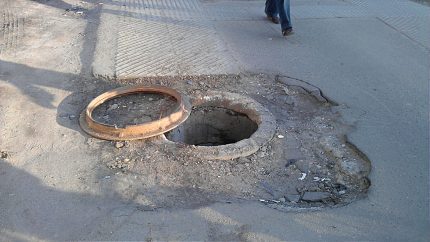
You can mount cast iron hatches everywhere, but it is most effective and expedient to include such elements in communication systems located at docks and airports, on busy highways, heavy parking lots, caterpillar and other agricultural machinery.
In places with medium or low load, cast iron is completely optional. But if the owner still wants to do this, no one can forbid him.
Why are plastic products interesting?
Plastic hatches are made by injection molding of polyvinyl chloride. To enhance the working qualities, the composition is enriched with composite additives or equipped with fittings compatible with products. Models are not afraid of pedestrian loads. Usually located where there is no traffic.
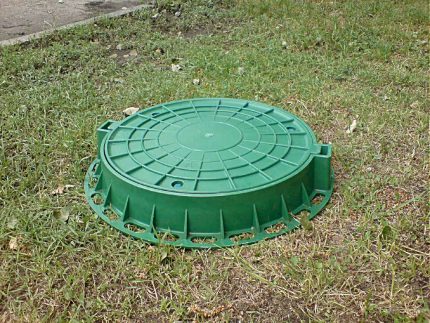
The main advantages of plastic hatches are light weight, intrinsic safety, independence from weather and temperature, long service life and reasonable cost. They put them mostly over plastic wells. There is only one minus - the impossibility of installation in the field of heavy traffic.
Polymer sand options
Sand-polymer models are produced by injection molding followed by hot pressing.
For their manufacture, materials such as:
- different fraction sand;
- thermoplastic polymer elements;
- persistent industrial dyes.
The creation process is built on the basis of advanced technological solutions and makes it possible to produce externally attractive, wear-resistant and durable products with minimal financial costs.
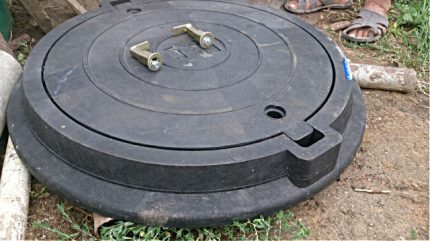
Polymer-sand hatches are marked in the form of the letter "L".
The size is determined by two indicators:
- 690x55 mm on the cover;
- 750x90 mm on the body;
The first number indicates the length along the diagonal, the second indicates the height. These parameters are considered optimal for communication networks for various purposes.
Lightweight hatches made of sand-polymer mixture have the following advantages:
- minimum weight compared to other similar products;
- low cost, allowing significant savings in the process of arranging communication networks;
- long operational period, which, according to the manufacturer, is about 50 years;
- elementary transportation and a simple installation process that does not require the involvement of additional labor or specific expensive equipment;
- resistance to aggressive manifestations of the environment, temperature extremes, peak heat / cold, direct sunlight, shock and other mechanical damage;
- neutrality in contact with alkalis, acids, alcohol compounds and technical oils;
- a variety of shapes, shades, designs and the external decor of the covers.
Another indisputable plus of polymer-sand details is safety. A piece of cast iron can be stolen at any time for the purpose of sale for scrap metal.
The polymer hatch in this regard is not in demand and will always remain in its place even in a remote unguarded zone that lies outside the control of private or state video surveillance.
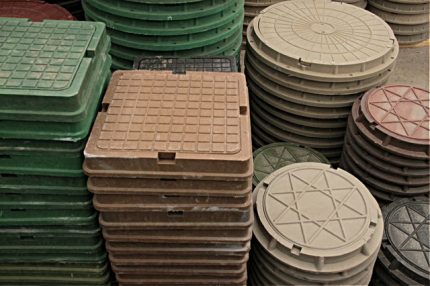
Polymer-sand models can easily withstand loads of up to 3 tons. They are placed in places with medium or low traffic intensity. They are mounted in pedestrian and green areas, in internal car parks of cars, parks, squares and territories located near apartment buildings and private cottages.
Nuances of composite modules
Composite is a new innovative material. It differs in thermal activity and contains fiberglass, polyester resins, calcite and other specific additives. At a temperature of 100 degrees is subjected to hot pressing. As it cools, it hardens and acquires good strength characteristics.

Composite hatches withstand various loads, which depend on the product class: L - up to 1.5 tons, C - up to 12.5 tons, T - up to 25 tons, TM - up to 40 tons. And also reliably serve for 20 years or more . At the end of the operational period are recyclable.
The advantage of composite hatches is expressed in the following positions:
- optimal weight of the finished product;
- practical constructional device;
- rich tint palette;
- resistance to fading, temperature extremes, severe frost, heat, ultraviolet and chemical exposure;
- slow combustibility.
Elements from the composite serve for a long time and hardly wear out. They withstand mechanical loads of up to 40 tons, but cost significantly less than cast iron counterparts. Under the influence of intense heat they lose their stiffness and become viscous. At such a moment, traces of heels may remain on the hatches.
The specifics of rubber products
Rubber sewer manholes perform the same functions as other products from other materials. But they have their own specific qualities and characteristics.
They are made of rubber, plasticizers, fillers, stabilizers and additional substances. After volcanic treatment, this mixture turns into a durable hatch, resistant to wear, and easily tolerating contact with oils, acids and alkalis.

Among the main advantages of rubber products:
- light weight;
- immunity to corrosion;
- resistance to cracking;
- convenient transportation;
- simplified installation process;
- the ability to install directly in hot asphalt;
- more loyal value compared to cast iron counterparts.
Rubber hatches are suitable for installation above plastic wellslocated in parks and green areas, on sports grounds, car parks, sidewalks and roads with weak traffic.
Concrete covers
Reinforced concrete hatches for sewer networks are used extremely rarely due to an excessively large mass, a problematic installation.
The main advantages of concrete models:
- uniform density;
- strength and durability;
- resistance to destructive processes.
Most often, such products are used where the mouth of the outlet well has non-standard dimensions.
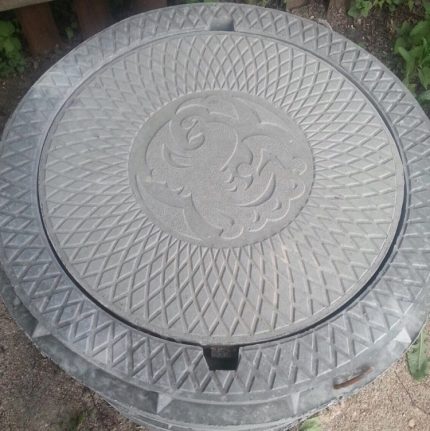
Rules for choosing sewer manholes
Choosing a hatch for drainage, storage and viewing sewer wells, first of all, you need to pay attention to the form. If the outlet of the communication system is in the form of a circle, a round part will be required for it.It is better to close a square or rectangular hole with an element of the same shape.
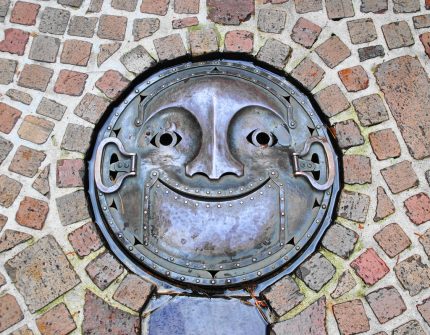
When the hatch is planned to be placed in a place subject to severe mechanical stress, it is worth choosing a model of cast iron. It will cost more than composites and polymers, but will last longer and withstand the constant pressure of passing heavy trucks.
For the conditions of private home ownership, spending money on such a hatch is not necessary, even if the owners have a heavy truck. One-time trips will easily transfer both composite and polymer analogues.
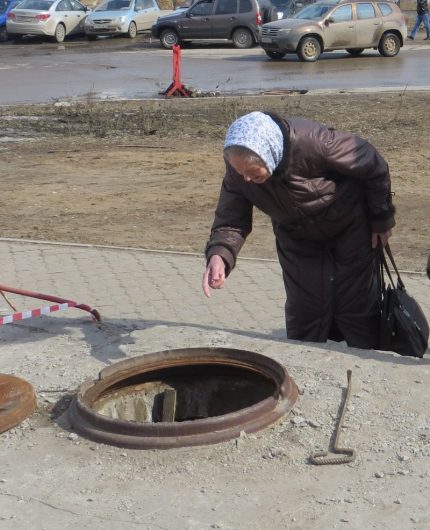
For installation in an open area, it is better to choose models equipped with a locking element. Which is able to protect the cast-iron hatch from theft for the purpose of subsequent sale in recyclables.
It is not possible to sell polymer and composite parts for the sake of profit, but they can be carried away by hooligans or teenagers. Therefore, such models will not be prevented by a reliable lock or lock.
Conclusions and useful video on the topic
Video # 1. How to install a sewer hatch on the site yourself:
Video # 2. Strength testing of polymer and cast-iron sewer manholes:
Video # 3. What are the dangers of sewer hatches of foreign manufacture?
In choosing a suitable hatch, it is necessary to take into account its future location, the level of potential load and climatic conditions in which the operation will take place.
Ignoring any of these important parameters will negatively affect the purchase and it will not bring the desired results. A model that does not meet the general criteria will not cope with the task and will quickly fail. Owners will have to spend money repeatedly to purchase a more suitable product.
Please write comments, ask questions, post a photo on the topic of the article in the block below. Tell us about how you bought a hatch for arranging sewers in a suburban area. Share your own criteria based on which you made your choice.

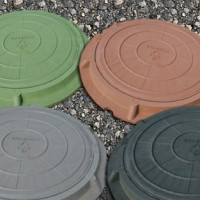 Sewer polymer hatches: types and characteristics + features of use
Sewer polymer hatches: types and characteristics + features of use 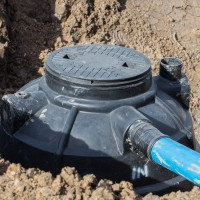 Sewer wells: full classification and examples of arrangement
Sewer wells: full classification and examples of arrangement  Pipes for domestic sewage in the house: a comparative overview of modern types of pipes
Pipes for domestic sewage in the house: a comparative overview of modern types of pipes 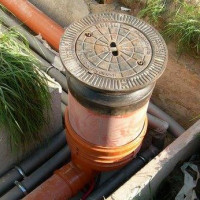 Plastic sewer wells: varieties + installation features
Plastic sewer wells: varieties + installation features 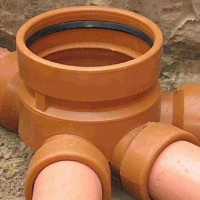 Sewer pipes PVC and HDPE for outdoor sewage: types, characteristics, advantages and disadvantages
Sewer pipes PVC and HDPE for outdoor sewage: types, characteristics, advantages and disadvantages 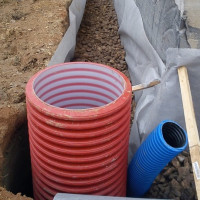 Plastic wells for drainage: device, types, classification, installation instructions
Plastic wells for drainage: device, types, classification, installation instructions  How much does it cost to connect gas to a private house: the price of organizing gas supply
How much does it cost to connect gas to a private house: the price of organizing gas supply  The best washing machines with dryer: model rating and customer tips
The best washing machines with dryer: model rating and customer tips  What is the color temperature of light and the nuances of choosing the temperature of the lamps to suit your needs
What is the color temperature of light and the nuances of choosing the temperature of the lamps to suit your needs  Replacement of a geyser in an apartment: replacement paperwork + basic norms and requirements
Replacement of a geyser in an apartment: replacement paperwork + basic norms and requirements
Polymer is better, even for placement on the roads. Our central street is wide, and the road is made of gravel and sand, so it is impossible to accelerate. A neighbor recently conducted water and decided to close the joint to the water supply network with a plastic sewer hatch, rather than bury it, as is customary in our village. Everything turned out pretty well. He laid it right on the road, and set a reflective pole nearby. Throughout the fall and winter, no one disturbed him. Pig-iron, I’m sure, would be pulled off by peasants to turn in for metal for the sake of drinking.
I agree. There are no practical minuses for polymer hatches. And if the state is slowly responding to new products, then for private households there are no obstacles to installation.
Praise the private trader further. Your state is always g # obviously, and the private trader well done. Although the reason is always in man.A little private trader already poisons, substitutes and deceives. Praise him further until you choke ....
Hello. In Ivan's comment there are not even any hints at what state is bad. “Slowly responding” - most likely, it was meant that the verification and registration procedure took a lot of time to comply with GOST, JV, etc., while a bunch of documents to private substrates was unnecessary.
And why are you so scolding private traders and standing up for the state? Are you a representative? Here in the next topic, we need a person to answer for the availability of gas fuel from the representatives of the state apparatus ... 🙂 Be in touch, if that.
Hello! The author, under the photograph of KASI hatches, wrote, “For more complex operational frameworks, enterprises produce special high-strength and hardy hatches weighing about 150 kg, capable of withstanding pressure of about 40 tons ...”
I must correct you, Nikolai. KASI hatches are not made of gray cast iron of the SCH-20 brand, but from high-strength cast iron (we often use the concept of malleable cast iron in the people) of the VChShG-500-7 brand. Such hatches, by virtue of the material used, are an order of magnitude lighter than analogues of gray cast iron.
For example, the KASI hatch of the KDU81P model withstanding a load of 40 tons (D400) weighs only 60 kg. Model KCU71P (C250) withstands 25 tons, weighs 52 kg. Installing such a hatch will not be difficult, even alone. KASI hatches are ideal for installation on roads and highways. They are also anti-vandal and do not make noise when run over. Separate conversation BEGU hatches ... But this is another story. 😉